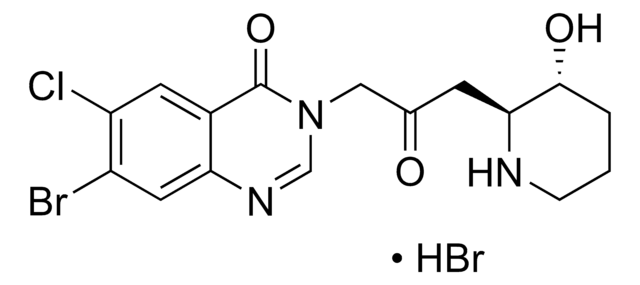SML4058
Florfenicol

≥98% (HPLC)
Synonyme(s) :
(-)-Florfenicol, 2,2-Dichloro-N-((1R,2S)-3-fluoro-1-hydroxy-1-(4-(methylsulfonyl)phenyl)propan-2-yl)acetamide, 2,2-Dichloro-N-[(1S,2R)-1-(fluoromethyl)-2-hydroxy-2-[4-(methylsulfonyl)phenyl]ethyl]acetamide, SCH 25298
About This Item
Produits recommandés
Niveau de qualité
Pureté
≥98% (HPLC)
Forme
powder
Couleur
white to beige
Solubilité
DMSO: 2 mg/mL, clear
Température de stockage
-10 to -25°C
Chaîne SMILES
ClC(C(N[C@@H]([C@H](O)C1=CC=C(S(C)(=O)=O)C=C1)CF)=O)Cl
Actions biochimiques/physiologiques
Florfenicol is a broad-spectrum antibiotic that is primarily used in veterinary medicine to treat respiratory infections in cattle and swine, and to prevent Salmonella infection in poultry. It has favorable ADME properties and is a fluorinated analog of chloramphenicol that has good tissue penetration and is resistant to chloramphenicol acetyltransferase inactivation. Florfenicol inhibits ribosomal activity and effectively inhibits bacterial protein synthesis, which makes it effective against various bacteria. However, oral administration of florfenicol may alter animal microbiota.
Mention d'avertissement
Danger
Mentions de danger
Conseils de prudence
Classification des risques
Aquatic Acute 1 - Aquatic Chronic 1 - Repr. 2 - STOT RE 1
Organes cibles
Liver,Brain,Testes,Spinal cord,Blood,gallbladder
Code de la classe de stockage
6.1C - Combustible acute toxic Cat.3 / toxic compounds or compounds which causing chronic effects
Classe de danger pour l'eau (WGK)
WGK 3
Point d'éclair (°F)
Not applicable
Point d'éclair (°C)
Not applicable
Certificats d'analyse (COA)
Recherchez un Certificats d'analyse (COA) en saisissant le numéro de lot du produit. Les numéros de lot figurent sur l'étiquette du produit après les mots "Lot" ou "Batch".
Déjà en possession de ce produit ?
Retrouvez la documentation relative aux produits que vous avez récemment achetés dans la Bibliothèque de documents.
Notre équipe de scientifiques dispose d'une expérience dans tous les secteurs de la recherche, notamment en sciences de la vie, science des matériaux, synthèse chimique, chromatographie, analyse et dans de nombreux autres domaines..
Contacter notre Service technique








